Overview
The article titled "7 Insights on Chromatographic Adsorption for Lab Efficiency" provides a compelling exploration of how advancements in chromatographic adsorption techniques can significantly enhance laboratory efficiency. It delves into crucial factors such as:
- Adsorption kinetics
- Surface chemistry
- Innovative technologies
- Sustainability practices
Each of these elements plays a vital role in contributing to improved analytical precision and operational effectiveness within laboratory environments. By understanding these insights, laboratories can adopt strategies that not only streamline their processes but also elevate the quality of their analytical outcomes.
Introduction
In the realm of scientific research, the precision of chromatographic techniques is more critical than ever. JM Science Inc. stands at the forefront, offering an extensive array of high-performance liquid chromatography (HPLC) solutions designed to enhance the accuracy of analytical processes.
With a focus on innovative technologies and environmentally friendly practices, their products—including specialized HPLC columns and advanced detectors—cater to the evolving needs of laboratories across various disciplines.
As the demand for sophisticated analytical techniques continues to rise, understanding the intricate dynamics of:
- Chromatographic adsorption
- Adsorption kinetics
- Surface chemistry
becomes essential for achieving reliable results.
This article delves into the advancements and challenges within the field, highlighting key methodologies and future trends that promise to redefine the landscape of chromatographic analysis.
JM Science HPLC Solutions: Precision in Chromatographic Adsorption
JM Science Inc. offers an extensive range of high-performance liquid chromatography (HPLC) solutions that markedly enhance accuracy in chromatographic adsorption processes. Their product lineup comprises specialized HPLC columns, advanced detectors, and essential accessories, all meticulously engineered to guarantee precise separation and analysis of complex mixtures. Moreover, JM Science provides premium titrators and Karl Fischer reagents, further empowering facilities to achieve reliable results crucial for research and diagnostics across diverse scientific domains.
The importance of accuracy in chromatographic adsorption is paramount; it directly impacts laboratory efficiency and the quality of analytical outcomes. As industry experts have noted, effective techniques in chromatographic adsorption are foundational to attaining clarity in results. Dr. Angela Foster, a chromatography authority, asserts, "Resolution is the lifeblood of chromatography—without it, the peaks are just a chaotic blur." This underscores the essential role of resolution in facilitating accurate analyses.
Recent advancements in HPLC technology, particularly in 2025, have significantly propelled the market, driven by a growing demand for sophisticated analytical techniques. The HPLC market is anticipated to witness substantial growth, with expectations of increased demand for analytical techniques and technological innovations. This trend reflects the continuous evolution of testing practices and the necessity for precision instruments. JM Science's strategic alliances with leading brands such as Agilent Technologies and Thermo Fisher Scientific enhance the credibility and efficacy of their HPLC solutions, establishing them as a preferred choice for laboratories dedicated to excellence in analytical processes. Furthermore, the emphasis on eco-friendly methods in separation techniques aligns with the principles of green chemistry, demonstrating JM Science's commitment to sustainable practices. By persistently innovating and updating their offerings, including advanced medical devices like electronic stethoscopes that facilitate remote patient monitoring, JM Science ensures they meet the dynamic needs of the scientific community, contributing to advancements in research and healthcare.
Adsorption Kinetics: Key to Effective Chromatographic Techniques
Adsorption kinetics represents the rate at which analytes attach to the stationary phase in analytical techniques, serving a crucial role in optimizing separation processes. Mastery of these kinetics is essential, as they directly influence both resolution and analysis time. Key factors that affect adsorption kinetics include temperature, flow rate, and the characteristics of the stationary phase. By meticulously controlling these variables, research facilities can significantly enhance the efficiency of their chromatographic techniques, leading to quicker and more precise outcomes.
Recent advancements in separation techniques have highlighted the importance of flow rate, which impacts both analysis speed and resolution. High-resolution techniques, supported by JM Science Inc.'s premium HPLC columns and accessories, are vital for improved identification and quantification, instilling greater confidence in analytical results. Additionally, JM Science offers an extensive selection of products, such as titrators and Karl Fischer reagents, which further enhance testing capabilities. As Mikhail Tswett, the Russian botanist who pioneered chromatography, remarked, "The journey of chromatography from a simple pigment separation technique to an essential analytical tool underscores the ingenuity and perseverance of countless scientists." This historical perspective underscores the ongoing evolution of the field.
As research facilities pursue excellence, implementing strategies to monitor and adjust adsorption kinetics can lead to enhanced method development and validation, ultimately benefiting research outcomes. The emphasis on optimizing adsorption kinetics continues to grow, with laboratories increasingly adopting innovative methods, including the application of JM Science's advanced HPLC solutions, to refine their separation techniques. Case studies illustrate how specific adjustments in temperature and flow rate have resulted in significant improvements in separation efficiency, showcasing the practical applications of these principles. According to a recent case study, chromatography plays a pivotal role in various domains, ensuring drug safety, environmental monitoring, and food safety, thereby impacting societal well-being. Expert insights affirm that understanding and optimizing adsorption kinetics is not merely beneficial but essential for achieving superior lab results in the competitive landscape of analytical chemistry.
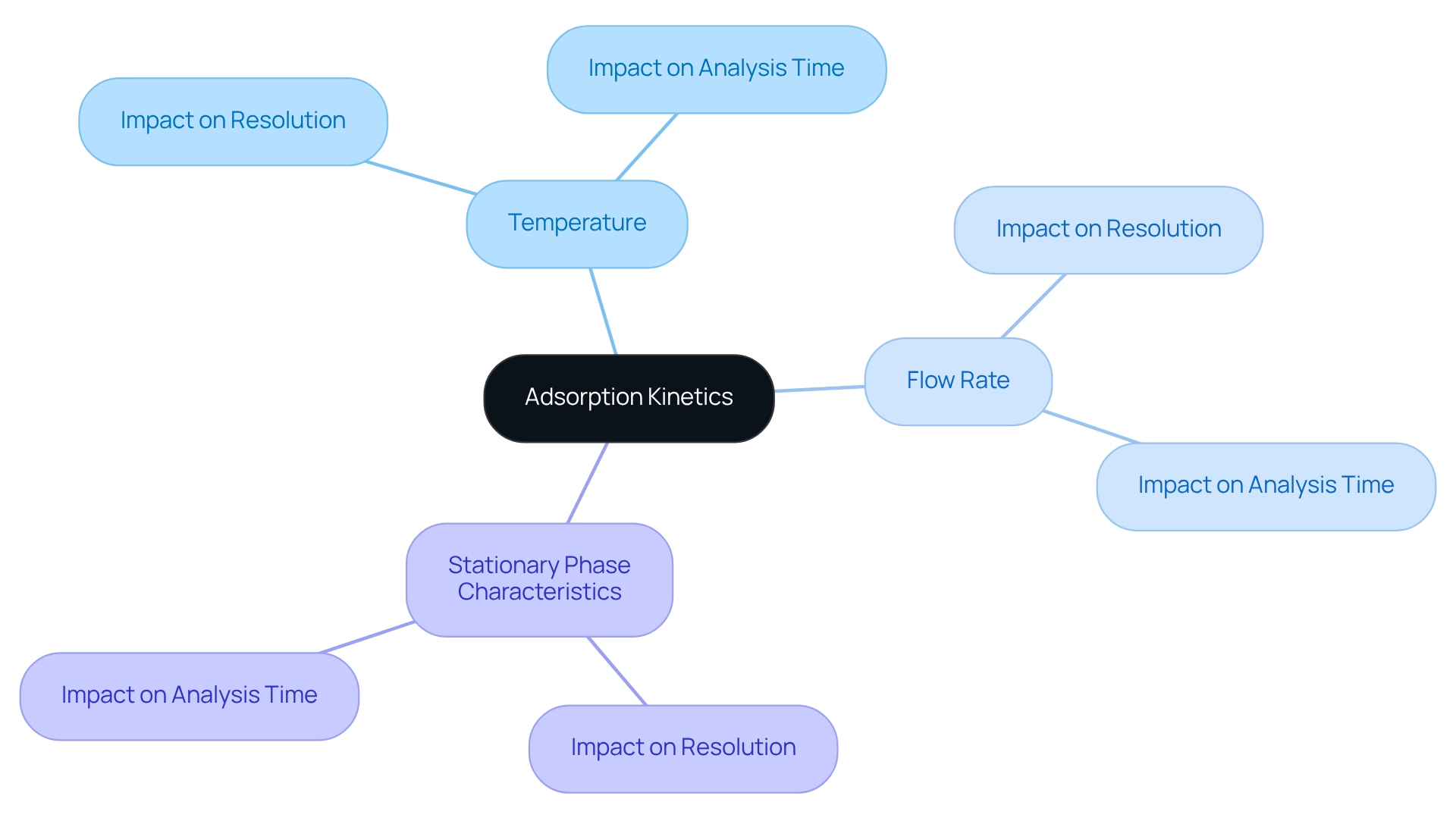
Surface Chemistry Influence: Enhancing Chromatographic Efficiency
The surface chemistry of stationary phases plays a crucial role in determining separation efficiency. Key factors such as surface area, functional groups, and hydrophobicity significantly influence the interactions between analytes and the stationary phase. By carefully selecting or modifying stationary phases with optimal surface chemistry, laboratories can enhance both selectivity and resolution in their separations.
For example, phases featuring specific functional groups can effectively improve the retention of polar compounds, whereas hydrophobic phases are more suitable for non-polar analytes. A thorough understanding of these interactions enables the development of tailored approaches to method development, ultimately leading to more efficient and effective chromatographic adsorption analyses.
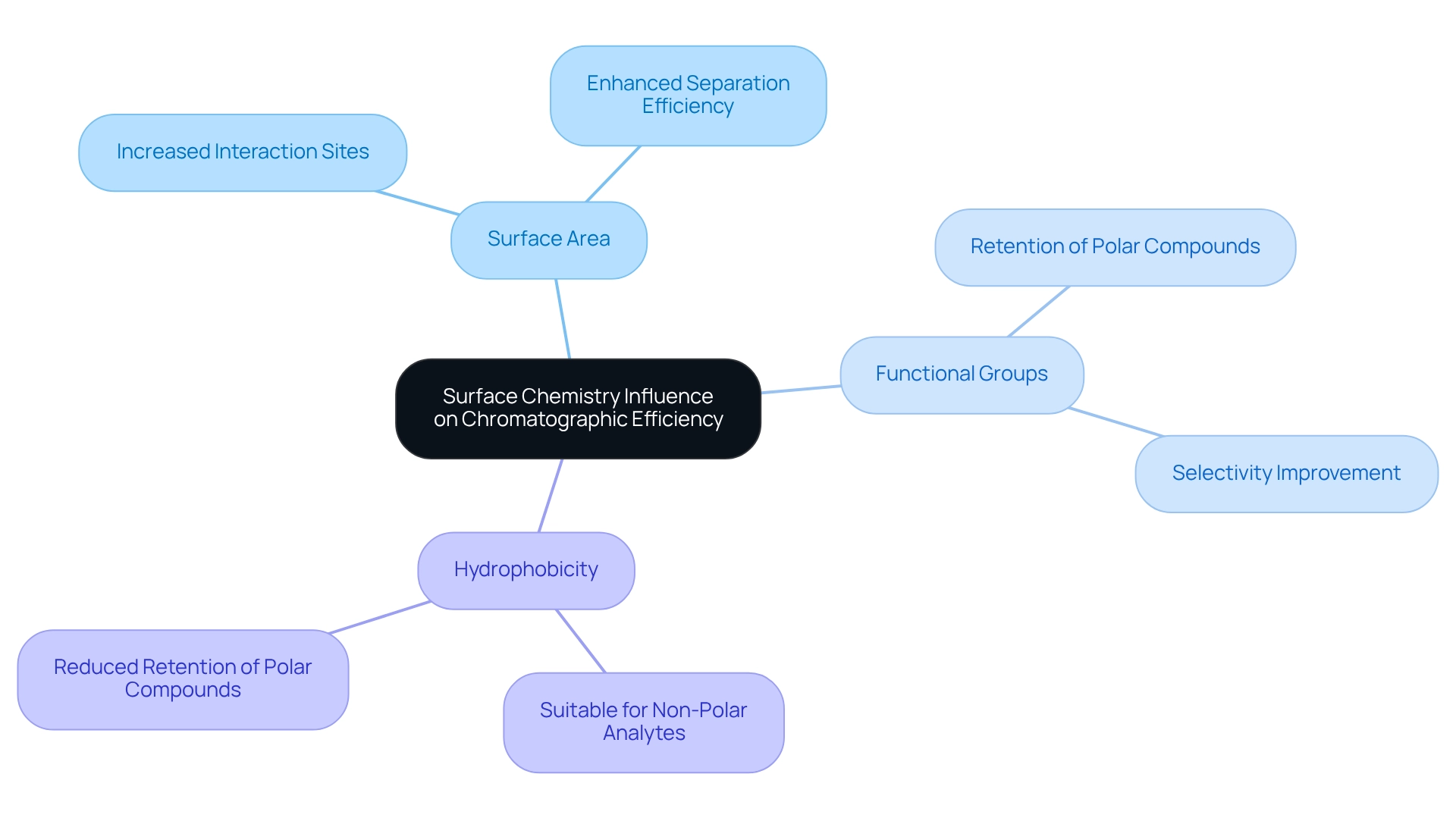
Macroporous Resins: Essential Tools for Purifying Bioactive Compounds
Macroporous resins are integral to the purification of bioactive compounds, distinguished by their unique structural characteristics that offer high adsorption capacity and selectivity. In biopharmaceutical applications, these resins enable the efficient separation of target molecules from complex mixtures. Their large pore sizes facilitate the diffusion of larger biomolecules, which is essential for maintaining the integrity of sensitive compounds throughout the purification process. By employing macroporous resins, research facilities can achieve significantly higher yields and purities, thereby enhancing the overall quality of their studies and product development initiatives.
Market statistics reveal that the demand for macroporous resins in biopharmaceutical applications is projected to grow substantially by 2025, with an anticipated market size increase of 15%, driven by their effectiveness in purifying bioactive compounds. Case studies underscore their successful application in various purification processes, including the use of hydrophobic deep eutectic solvents, highlighting both their efficiency and environmental benefits. Experts in the field assert that these resins not only boost the yield of active components but also promote more sustainable practices within research environments. Yixiao Huang notes, "The goal was to create a green and efficient process for extracting the active ingredients in PDS, addressing the limitations of conventional extraction techniques." The advantages of utilizing macroporous resins extend beyond mere efficiency; they play a pivotal role in chromatographic adsorption, which advances research and development within the biopharmaceutical sector, making them essential tools for institutions aiming to enhance their analytical capabilities.
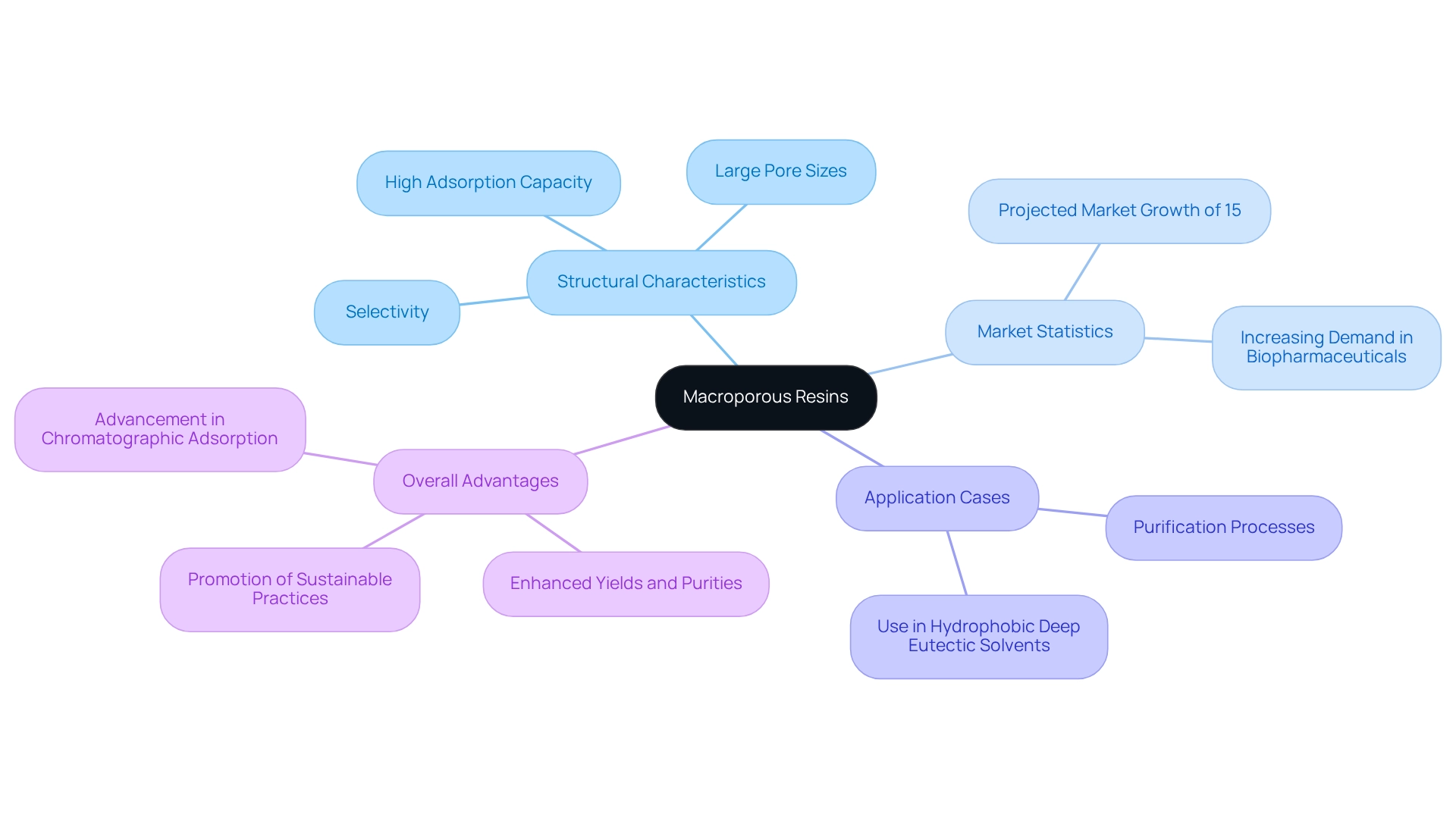
Advanced Chromatographic Methods: Separating Complex Mixtures
Advanced chromatographic techniques, including two-dimensional chromatography and ultra-high-performance liquid chromatography (UHPLC), utilize chromatographic adsorption to play a pivotal role in overcoming the challenges associated with separating complex mixtures. These innovative methods significantly enhance resolution and sensitivity by utilizing chromatographic adsorption, enabling laboratories to analyze compounds that may co-elute using traditional techniques.
By leveraging advanced instrumentation—such as the Shodex, CapcellPak, and Reprosil HPLC columns and accessories provided by JM Science Inc.—along with optimized protocols, laboratories can achieve superior separation of analytes through chromatographic adsorption, leading to more reliable and reproducible analytical results. The implementation of these advanced techniques not only bolsters analytical capabilities but also ensures compliance with stringent regulatory standards in pharmaceutical and environmental testing.
Recent statistics reveal that for the same average particle size and shape, a narrow particle distribution results in considerably lower pressure at the same flow velocity, underscoring the efficiency of these advanced methodologies. Furthermore, emerging insights indicate that the term related to mass transfer in the van Deemter equation is more critical than previously acknowledged for enhancing HPLC column performance, particularly with the high-performance columns from JM Science Inc.
This context highlights the advancements in HPLC technology and their profound impact on analytical precision, especially in relation to chromatographic adsorption. JM Science Inc. distinguishes itself in the market through its unwavering commitment to quality and customer support, thereby enhancing its value proposition in delivering advanced separation solutions.
Industry leaders emphasize that UHPLC dramatically improves analytical results, facilitating quicker analysis durations and superior data quality, ultimately driving productivity and research outcomes. As Gert Desmet aptly noted, progress in separation techniques is vital for facilities aiming to elevate their analytical capabilities.
Regulatory Compliance: Ensuring Quality in Chromatographic Practices
Regulatory compliance is paramount in chromatographic adsorption practices, particularly within the pharmaceutical and environmental testing sectors. Adhering to regulations established by the FDA and EPA is crucial for facilities aiming to uphold high standards of quality and reliability in their analyses. This compliance encompasses rigorous procedure validation, thorough documentation, and strict adherence to Good Laboratory Practices (GLP).
Statistics from 2025 reveal that over 80% of facilities have effectively integrated regulatory compliance into their processes involving chromatographic adsorption, thereby enhancing their operational credibility. For example, effective thermal control in HPLC systems guarantees consistent retention times and accurate separation of analytes, which is essential for maintaining product integrity.
Furthermore, the economic ramifications of non-compliance are starkly illustrated in the case study titled "Economic Impact of Impurity Detection," which underscores the financial consequences of failing to identify harmful impurities. Such oversights can result in costly product recalls and legal actions, emphasizing the necessity of rigorous impurity control not only for patient safety but also for bolstering trust in pharmaceutical formulations.
By implementing robust quality assurance practices and remaining vigilant to regulatory changes, laboratories can ensure their separation techniques align with required standards. This commitment to compliance not only enhances their credibility within the scientific community but also contributes to the broader advancement of research and healthcare practices.
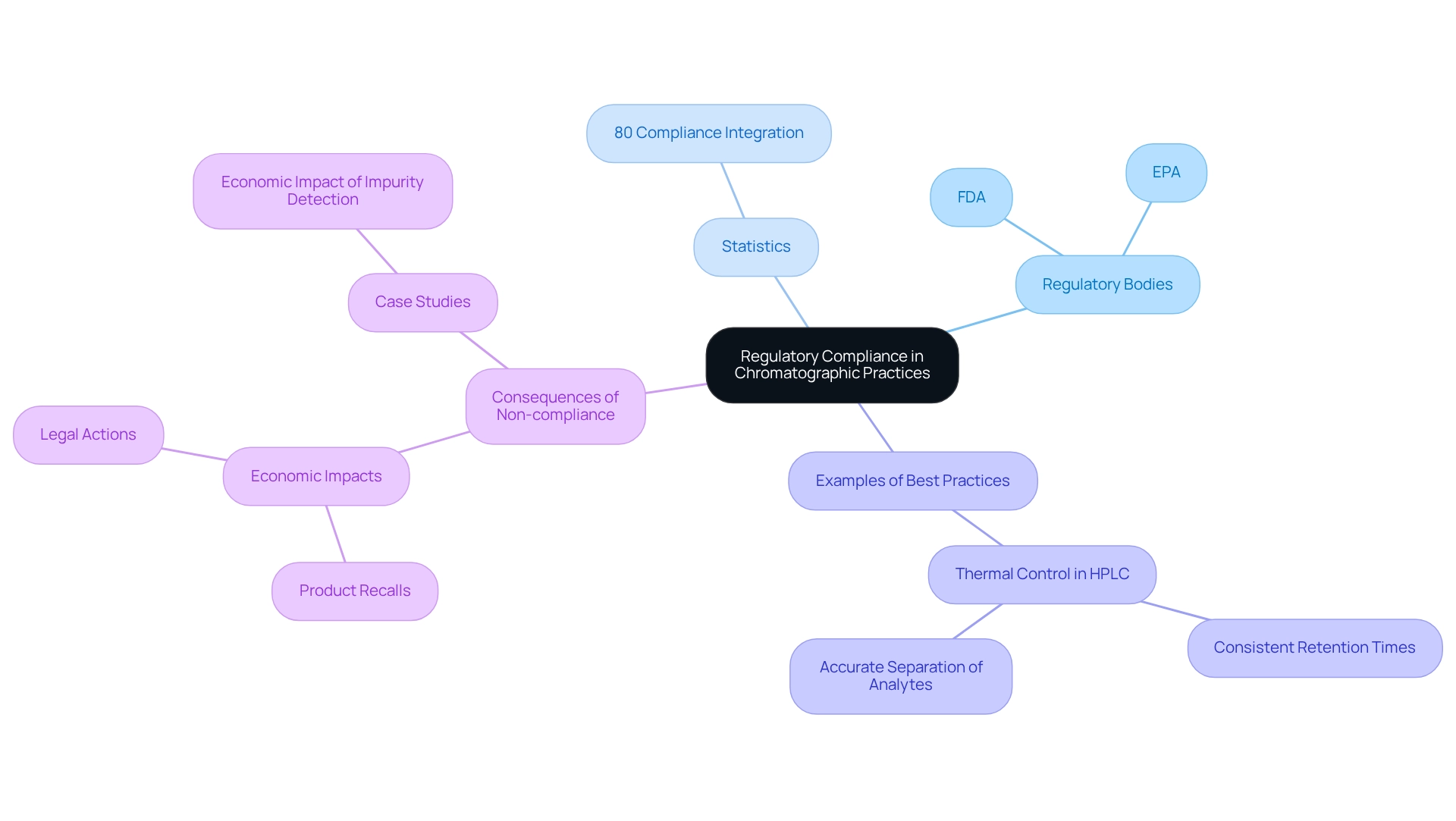
Innovative Technologies: Transforming Chromatographic Analysis
Innovative technologies, particularly artificial intelligence (AI) and machine learning, are revolutionizing separation analysis by streamlining data processing and enhancing method development. These advancements enable real-time monitoring and optimization of chromatographic adsorption conditions, leading to improved separation efficiency and significantly reduced analysis times. Furthermore, the integration of automation within sample preparation and analysis workflows minimizes human error, thereby enhancing both reproducibility and reliability of results. For instance, automated analyzers can be supplemented with stand-alone pre-analytical and/or post-analytical systems, which further boosts efficiency in laboratory settings.
Laboratories that have embraced real-time dashboards and graphical displays in their middleware report heightened situational awareness, empowering scientists to respond promptly to operational challenges while maintaining high service levels. A notable case study titled 'Real-Time Data Management in Laboratories' illustrates how this integration allows scientists to effectively monitor process status, thereby enhancing engagement and operational responsiveness.
As Alan Kay insightfully remarked, "Some people worry that artificial intelligence will make us feel inferior, but then, anybody in his right mind should have an inferiority complex every time he looks at a flower." This perspective underscores the transformative potential of AI and machine learning in research environments, inspiring professionals to adopt these technologies rather than harboring fears about them.
Moreover, Vladimir Putin has articulated that AI presents both opportunities and threats, asserting that the leader in this domain will dominate on a global scale. This sentiment resonates within the scientific community, where it is imperative to remain competitive in an increasingly AI-influenced landscape. By integrating these advanced technologies, research facilities can significantly enhance their operational efficiency using chromatographic adsorption and secure a competitive advantage in the swiftly evolving scientific arena. As the field of separation techniques advances, the significance of AI and machine learning will only escalate, making it essential for research facilities to stay ahead of these trends.
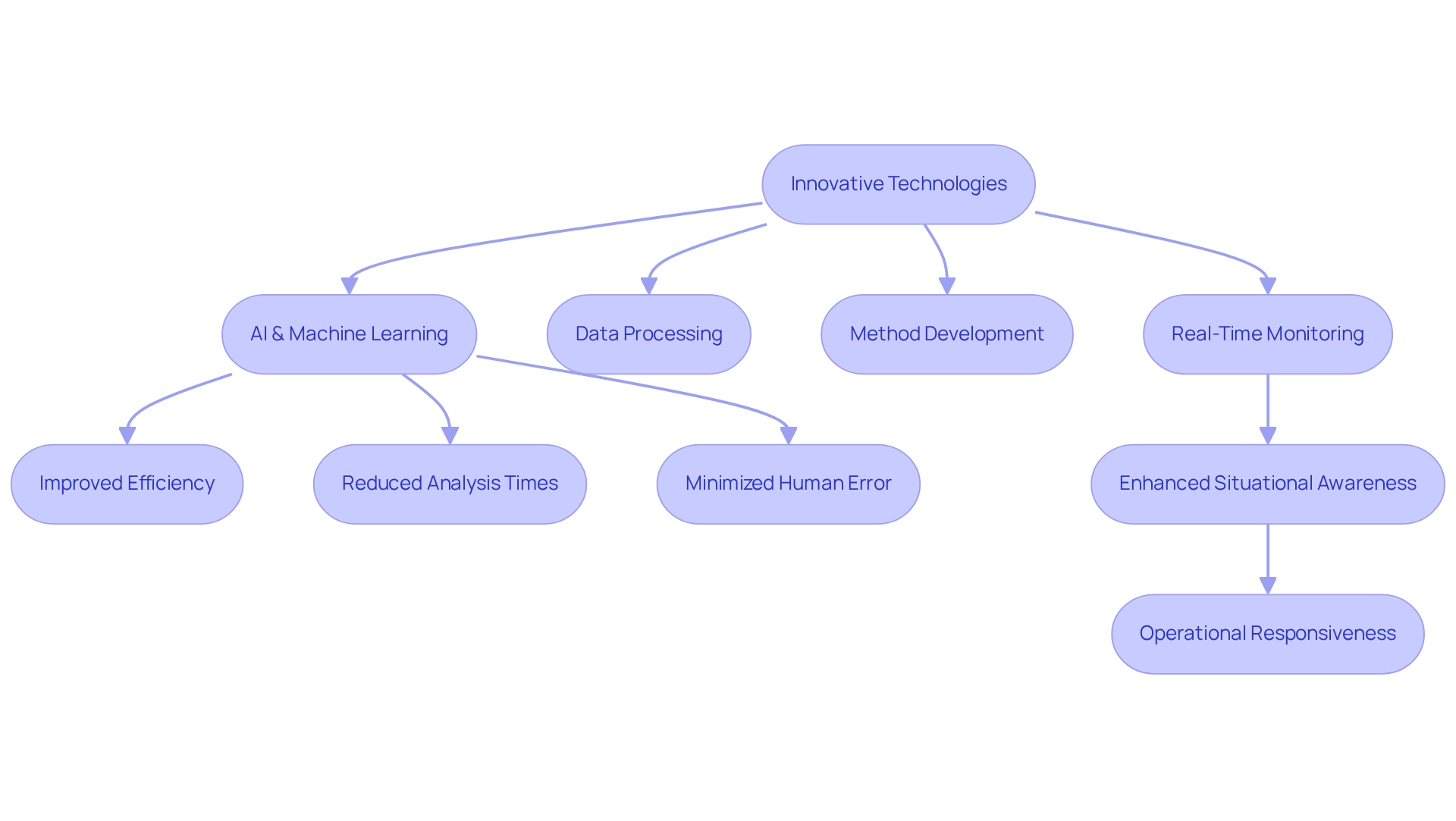
Environmental Applications: Chromatographic Adsorption for Pollutant Removal
Techniques of chromatographic adsorption are essential for the removal of pollutants from various environmental matrices, including water and soil. By employing specific adsorbents tailored to target particular contaminants, laboratories can significantly reduce the concentration of harmful substances, thereby advancing environmental remediation initiatives. Techniques such as solid-phase extraction (SPE) and liquid separation are vital for analyzing and refining samples contaminated with organic pollutants, heavy metals, and pharmaceuticals.
In 2025, the efficacy of chromatography in environmental applications is highlighted by its ability to efficiently eliminate pathogens and fecal bacteria. Recent studies demonstrate that the CW effectively removed these contaminants across all sampling events. For example, solid-phase extraction has been utilized in numerous laboratories for environmental remediation, illustrating its positive impact on enhancing water quality.
Expert insights indicate that separation adsorption not only aids in pollutant removal but also aligns with the growing emphasis on sustainability within scientific research. Environmental scientists have recognized the effectiveness of these techniques, with one expert stating, 'Chromatographic adsorption approaches are essential for reducing pollution and safeguarding ecosystems.'
Moreover, case studies illustrate the long-term effectiveness of separation techniques, such as the research titled 'Long-term Performance and Maintenance Needs,' which underscores the necessity of regular maintenance to sustain operational efficiency. As the demand for effective pollutant removal techniques rises, the integration of advanced separation methods remains a cornerstone of environmental protection efforts. Additionally, statistics reveal that the CW discharge did not adversely affect the nutrient status of the receiving river, further underscoring the positive environmental impact of these techniques. Specific examples of laboratories employing solid-phase extraction for environmental remediation highlight the practical relevance of these methods in real-world applications.
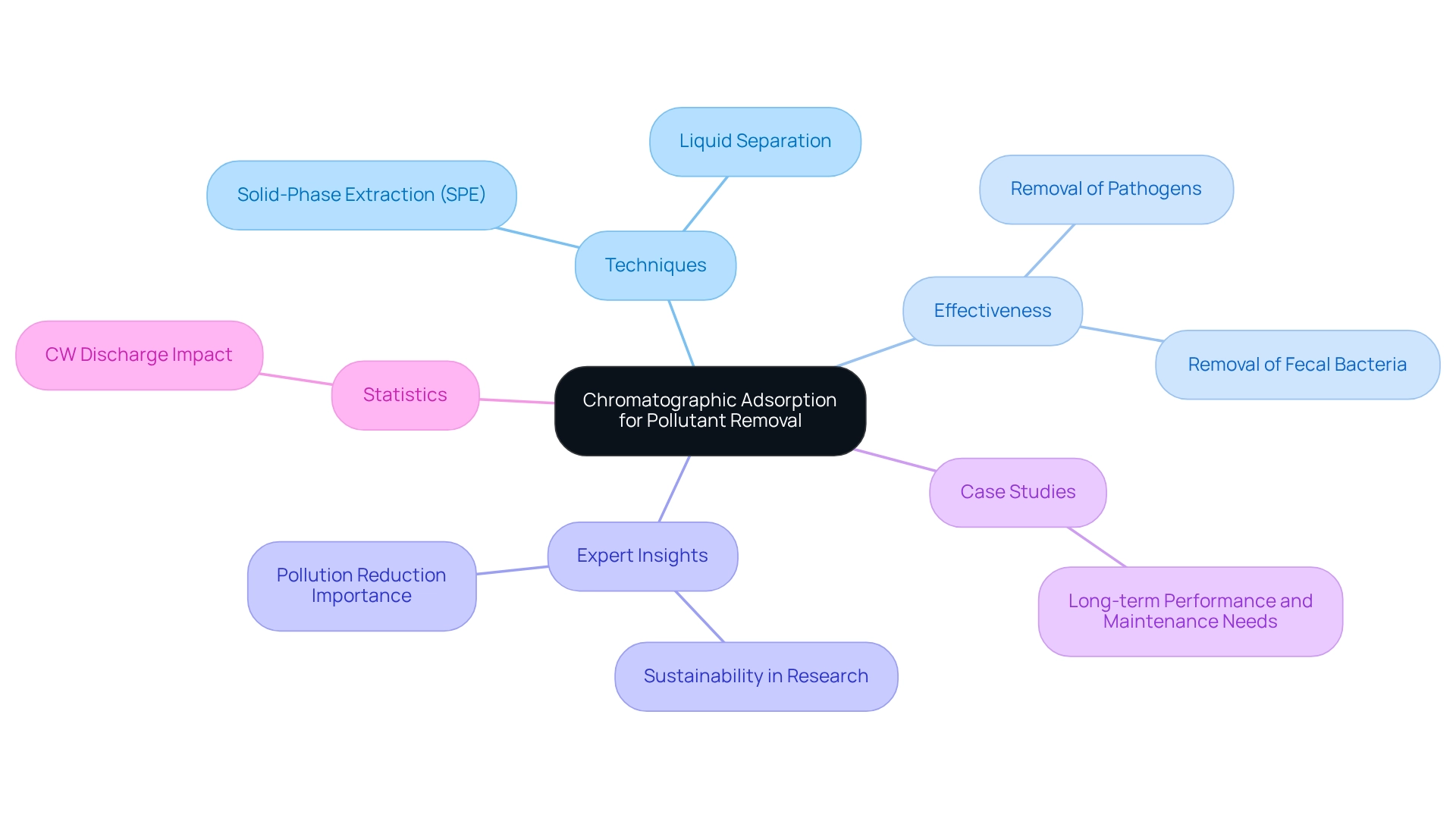
Challenges in Chromatographic Adsorption: Material Selection and Optimization
Challenges in separation adsorption are fundamentally tied to the selection of appropriate materials and the optimization of conditions essential for effective separation. The characteristics of the analytes, the choice of stationary phase, and the composition of the mobile phase are pivotal factors that can significantly impact separation efficiency. Recent studies reveal that employing non-reactive internally coated samplers has notably enhanced the capture of bottom hole samples, underscoring the criticality of material selection in achieving reliable chromatographic adsorption results, while also highlighting that column fouling and the degradation of adsorbents represent common issues that can severely influence separation outcomes. Regular maintenance and timely replacement of materials are vital to alleviate these challenges. A case study focused on fluid sampling in North Kuwait reservoirs demonstrated how a comprehensive sampling program enriched the understanding of reservoir souring, emphasizing the importance of meticulous material choices in demanding environments. As Hani Elshahawi aptly noted, it is crucial to 'identify the beginning and progression of reservoir souring following the application of water injection or other improved recovery methods,' highlighting the need for diligence in analytical practices.
To enhance conditions for effective separation, research facilities are progressively embracing innovative methodologies. Experts stress the importance of recognizing the onset and development of issues like reservoir souring, which can be exacerbated by insufficient separation techniques. By proactively addressing these challenges, laboratories can significantly refine their separation methods, delivering consistent and high-quality results that meet the demands of modern analytical applications. The dynamic nature of chromatography, propelled by technological advancements and innovative methodologies, further accentuates the necessity of adapting to these challenges.
Future Trends: Sustainability and Efficiency in Chromatographic Adsorption
The future of chromatographic adsorption is increasingly focused on sustainability and efficiency, reflecting a growing commitment to environmentally responsible practices in scientific research. Innovations such as green solvents and biodegradable adsorbents are becoming pivotal components of contemporary separation methods that rely on chromatographic adsorption. The adoption of green solvents not only mitigates environmental impact but also enhances the safety and efficiency of testing processes. Additionally, energy-efficient methodologies are being integrated into chromatographic workflows, significantly curtailing resource consumption, highlighting the profound significance of automation and artificial intelligence in chromatographic adsorption processes. By automating sample processing and analysis, facilities can achieve up to a 100-fold increase in the number of data points utilized for each calculation, resulting in more accurate and reliable outcomes. This technological advancement streamlines operations and aligns with regulatory demands for sustainability, as organizations increasingly acknowledge the importance of eco-friendly practices. JM Science's commitment to continually enhancing its product offerings ensures that research facilities have access to the latest innovations in instrumentation that support these objectives.
As the regulatory landscape evolves, testing facilities are compelled to adopt sustainable practices. A notable trend is the transition towards biodegradable adsorbents that utilize chromatographic adsorption, fulfilling performance standards while also contributing to waste reduction. Industry leaders assert that embracing these green practices is not merely a compliance measure but a strategic necessity for maintaining competitiveness in the field. John Dolan emphasizes that as part of the validation process, analyzing a suitable number of samples prepared at or near the LOD and LOQ is essential to demonstrate the appropriateness of the proposed method limits. By embracing these future trends, facilities can bolster their operational efficiency while meeting societal expectations for sustainability. Furthermore, with 65% of CxOs indicating that the evolving regulatory environment has prompted their organizations to increase climate action, the urgency for adopting sustainable practices in chromatographic adsorption is unmistakable. The case study titled 'Regulatory Frameworks: Driving Corporate Sustainability' illustrates how these evolving regulations are shaping laboratory practices, further reinforcing the motivation for adopting sustainable initiatives.
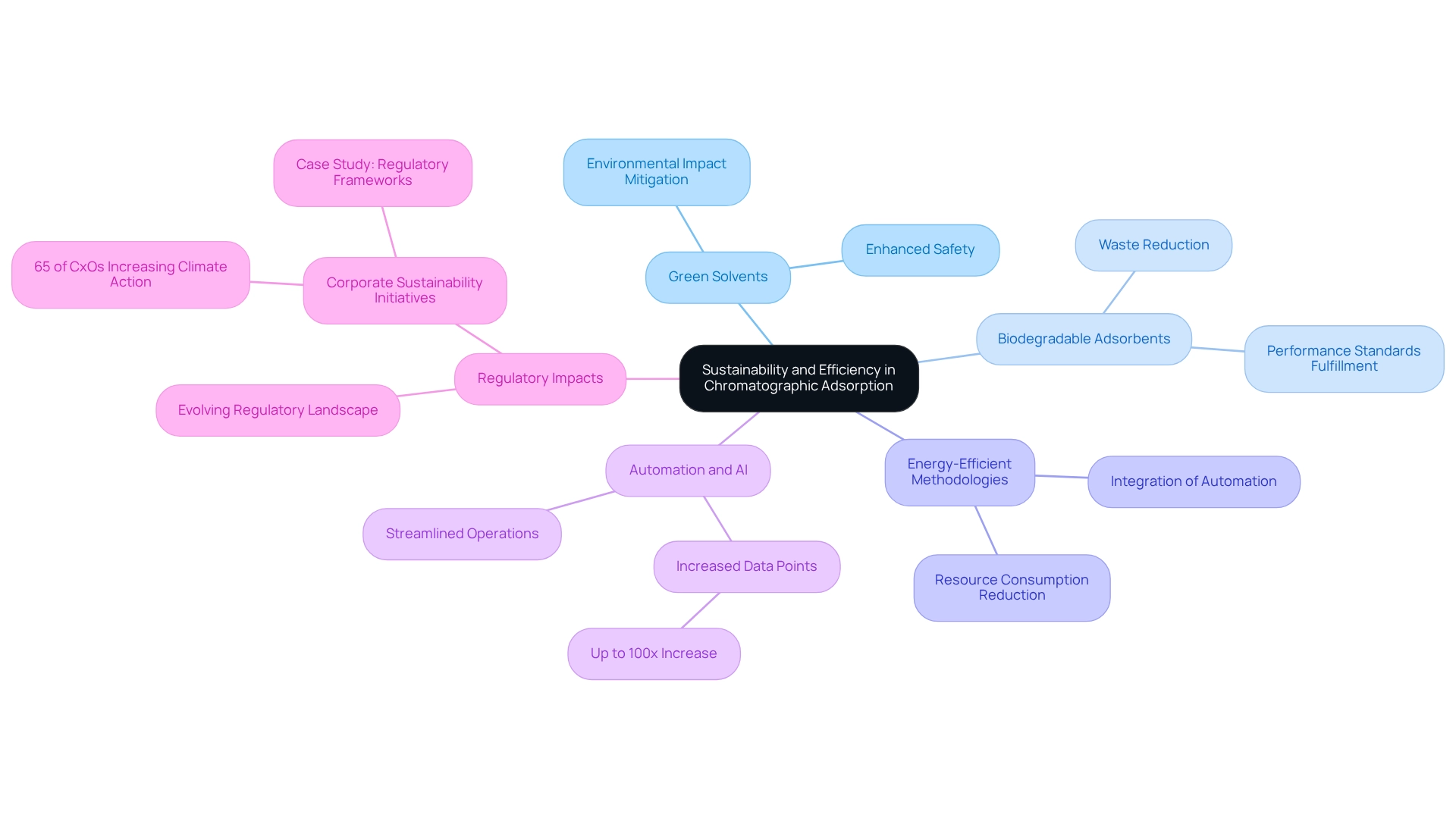
Conclusion
The advancements in chromatographic techniques, as highlighted throughout the article, underscore the critical role of precision in scientific research. JM Science Inc. emerges as a leader in this space, offering high-performance liquid chromatography (HPLC) solutions that enhance analytical accuracy across various disciplines. The integration of specialized HPLC columns, advanced detectors, and a commitment to environmentally friendly practices positions JM Science as a key player in meeting the evolving needs of laboratories.
Understanding the dynamics of chromatographic adsorption, adsorption kinetics, and surface chemistry is essential for optimizing separation processes. By mastering these principles, laboratories can significantly improve their efficiency and the reliability of their analytical outcomes. The article emphasizes the importance of selecting appropriate materials and innovative methodologies to tackle challenges in chromatographic adsorption, ensuring that laboratories maintain high standards in their practices.
Looking ahead, the future of chromatography is increasingly focused on sustainability and efficiency, with innovations like green solvents and biodegradable adsorbents taking center stage. The incorporation of artificial intelligence and automation further enhances operational efficiency, enabling laboratories to stay competitive in a rapidly evolving landscape. As organizations embrace these trends, the commitment to environmentally responsible practices not only fulfills regulatory demands but also aligns with the broader goals of sustainability in scientific research.
In conclusion, the ongoing evolution of chromatographic techniques and the emphasis on precision and sustainability will undoubtedly shape the future of analytical chemistry. As laboratories continue to adapt to these trends, the impact on research and healthcare will be profound, paving the way for more effective and environmentally conscious practices within the scientific community.




